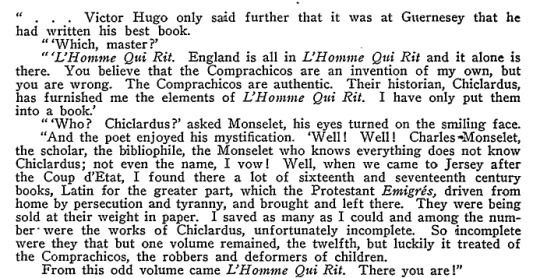#Being a monoglot Englishman is so totally embarrassing dude. And at my age.
Text
So fortunately (or perhaps very very unfortunately) there has been a breakthrough in the "comprachico" mystery, which I am now apparently committed to investigating.
I mentioned that the name/general description was brought up in some academic studies on jesters I was reading - one of these (the most recently published) actually does have a pretty exhaustive list of sources, though they're reproduced quite uncritically and with a lot of tortured speculation by the author. The only locatable english-language source the author used for their mention of "comprachicos" is a victorian book, "giants and dwarfs" by Edward Wood, published 1868. Not that impressive on its own, theres a lot of victorian pseudohistory out there. Interestingly though, it appears to have come out one year before l'homme qui rit, and cites a verifiably existant pre-victorian source. "Miscellanea curiosa, medica, psysica", a medical journal from 1670, published in Leipzig, Germany. This is also cited by the first book I mentioned.

This journal (as far as i can tell its the right one? the date is one year off) is available in full on Internet archive, along with Wood's book, both of which i will link at the end. Like many historical medical texts, it is written entirely in Latin. I, alas, due to my mere peasant's education, cannot read a word of it. I did briefly skim for the word 'comprachico', but since there is no mention of this word or of any specific individual or group carrying out the mutilations in Wood's book either, this seemed unlikely and I predictably did not find anything. I also looked out for diagrams that might seem to pertain to the folkloric "dwarfing" practice described by Wood. There were one or two that I thought might possibly be related but i won't share them here as i imagine many would rightfully find them upsetting.
However, I did wonder if the Leipzig journal might be the one referenced by Hugo in the actual in-universe action of l'homme qui rit, when ursus looks up gwynplaine's mutilation in an old Latin medical text. I double checked and the book owned by ursus is actually called "de denasatis" by "Dr John conquest". On the off-chance that this was anything resembling a real book, I searched for it and found a reddit thread linking another article, written in 1910, by John Boynton Kaiser. This article, from the Journal Of Criminal Law and Criminology, was pondering on the exact same question as I was - the origin of Hugo's comprachicos. On the topic of "artificial jesters", it again cites the same Leipzig journal as Wood.

It also goes into detail on Hugo's possible historical inspirations, for the story in general and specifically for the comprachicos. Kaiser claims, I think correctly, that even if the idea is not new, the word itself was made up by hugo. I used this tool, which scans for keywords in archived Google books going back to the year 1500, and there is no mention of comprachicos or any variation thereof until after the publication date of l'homme qui rit. The name is apparently a simple mashup of spanish words for "male child" and "purchase". or as google translate would have it, uh

Kaiser writes that in hugo's journals the author also considered other names for his "child-buying" group based on other languages, and he apparently wasn't sure what their ethnicity should be. This further points to the fact that the specific group itself is made up, though he apparently maintained among colleagues that it was real.

I should note that the English texts I have linked, if you are interested in reading them for yourself, are deeply disturbing in content as well as archaic and prejudiced in tone:
https://archive.org/details/b24887067
https://archive.org/details/s3id11855980/page/12/mode/2up?view=theater
https://scholarlycommons.law.northwestern.edu/jclc/vol4/iss2/8/
None of this, of course, proves definitively that such "artificial jester" practices were ever carried out in real life, by an organized group or otherwise. It moreso just indicates, as I suspected, that they weren't fully invented by Hugo. Kaiser's article claims there is other evidence, but i really dont know at this point. Honestly I'm now very much hoping that all this shit is completely made up, because Jesus fucking christ.
Anyway, aside from that, the 1910 article maintains that hugo documented his research and writing process extensively in his journals and personal papers. I'm quite excited by this prospect, as it might provide answers to some other questions I've been wondering about, such as the origins of the many unique character names. I'll have to see if anyone has translated any of this background material into English. Or perhaps i could learn French. Its getting to the point where I might have to just learn French
#Being a monoglot Englishman is so totally embarrassing dude. And at my age.#Also If I'm really serious about pursuing history learning French would honestly be a good start#Even if it would in my case be the equivalent of a weeb learning Japanese to read untranslated doujin#Anybody else ever wish they were an old timey Oxford type dude.#Instructed in Latin and ancient greek while getting their cock sucked in the dorms by the future secretary of the treasury or whatever#Nice work if you can get it#ableism //#racism //#l'homme qui rit#jester lore
6 notes
·
View notes